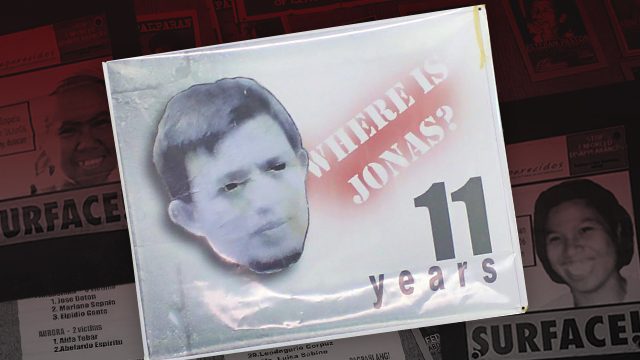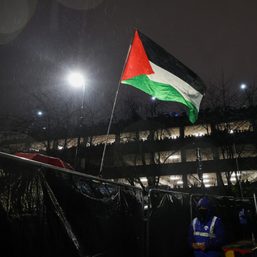SUMMARY
This is AI generated summarization, which may have errors. For context, always refer to the full article.

MANILA, Philippines – The two scenes are eerily familiar yet heartbreakingly different for Edita Burgos, the 75-year-old mother of activist Jonas Burgos, one of the highest-profile desaparecidos cases in the Philippines.
Edita sat calmly as cries quickly filled the small Malolos Regional Trial Court (RTC) Branch 15 on September 17 when the guilty verdict was read on army major general Jovito Palparan for the disappearance of University of the Philippines student activists Karen Empeño and Sherlyn “She” Cadapan.
A year ago, in a same sized courtroom in Quezon City, Edita also sat calmly while those around her teared up when army major Harry Baliaga was acquitted for the disappearance of Jonas.
Why was Palparan convicted and Baliaga acquitted?
Witnesses showed up in court for Karen and She, while the eyewitnesses for Jonas were never reached again when trial came.
(WATCH: Edita Burgos is behind Erlinda Cadapan in this video after the guilty verdict on Palparan on September 17, 2018)
(WATCH: Edita Burgos on October 12, 2017, after the acquittal of Army Major Harry Baliaga)
Jonas’ witnesses
Jonas was abducted from a restaurant in Quezon City in April 2007, a year after Karen and She were forcibly taken in June 2006 from a home in Hagonoy, Bulacan where they were staying for their immersion work.
The two cases went the same routes, starting first with the mothers filing for a petition for a Writ of Habeas Corpus before the Supreme Court which sought to compel state agents to produce the detainees in court.
In Jonas’ case, the Supreme Court tasked the Commission on Human Rights (CHR) to investigate. CHR investigators Carlos Royeras, Robinson Vinas, and Bayani Arago were able to personally talk to Jeffrey Cabintoy, a busboy at the Hapag Kainan restaurant in Quezon City where Jonas was taken from and hauled into a vehicle never to be seen again.
Cabintoy told the CHR he saw Baliaga as being among the men who took Jonas. The CHR found another witness – a waitress at the same restaurant. Using these testimonies, the Court of Appeals ruled in March 2013 on an Amparo petition that Baliaga was responsible for the disappearance of Jonas.
The CA also held the military accountable, which should have compelled them to launch a deeper probe into Jonas’ disappearance.
Later in 2013, Baliaga was charged with arbitrary detention at a Quezon City RTC but Cabintoy and the waitress could no longer be reached.
The CHR investigators took the stand instead and repeated to the court what Cabintoy told them.
Baliaga’s lawyers, knowing legal standards too well, opted not to present a defense, waiving the soldier’s right to present evidence.
In a decision promulgated on October 12, 2017, Judge Alfonso Ruiz II of Quezon City RTC Branch 216 ruled that the CHR investigators’ testimonies were mere hearsay.
“The reason for the exclusion of hearsay evidence is that the party against whom the hearsay testimony is presented is deprived of the right or opportunity to cross-examine the person to whom the statements are attributed,” Ruiz said.
But physical evidence always carries more weight than testimonies.
What Edita had were testimonies that the vehicle that carried Jonas had the plate number TAB-194. A vehicle with the same plate number was found to be impounded at the 56th Infantry Battalion Camp in Norzagaray, Bulacan, where Baliaga was previously assigned. (READ: Jonas Burgos: Trapped in a Web of Lives)
However, Ruiz said “this circumstantial evidence standing alone will not reach the quantum of proof required to overcome the constitutional presumption of innocence.”
Witnesses against Palparan
On the contrary for Karen and She, their witnesses withstood the entire ordeal of a court trial.
It helped that the witnesses – Raymond Manalo, Wilfredo Ramos, and Oscar Leuterio – were familiar with the work of, and sympathetic to, activists. Compared to a busboy and a waitress in Jonas’ case, the witnesses against Palparan were more likely to show up. (WATCH: People of the Philippines vs Jovito Palparan)
In fact, Palparan’s lawyers used this against the witnesses during hearings, accusing them of bias for being members of the human rights group Karapatan, which they called “a front organization of the CPP/NPA/NDF.”
Manalo, who positively identified Palparan as being one of the officials he saw while in detention with Karen and She, was initially picked up on suspicions of being a New People’s Army (NPA) rebel.
Ramos, who said he saw Palparan’s fellow convict Staff Sergeant Edgardo Osorio take Karen and She from their home in Hagonoy, was outrightly called an NPA by soldiers who testified.
For example, defense witness Private First Class Edward Neri called Ramos “a member of the New Peoples’ Army and a liar.”
Judge Alexander Tamayo, however, said that “despite efforts to discredit the prosecution witnesses, the defense failed to ascribe improper motive in their taking the stand against the accused much less pictured them as perjured and biased witnesses other than simply on account of being supposedly members of Karapatan.”
“For this reason, their unsubstantiated defense of denial and alibi can only be taken as mere subterfuge to exculpate themselves from the present criminal charges,” said Tamayo.
For their side, Palparan’s only witness was himself where he again accused the Left of being out to “destroy him.” Palparan has been portrayed by the Left and human rights advocates as the face of extrajudicial killings and enforced disappearances during former president Gloria Macapagal Arroyo’s term.
Jonas, Karen, and She are among the 146 still missing from 2001 to 2010 under the Arroyo administration, as documented by Families of Victims of Involuntary Disappearance (Find). (READ: Poor law implementation denies desaparecidos justice)
Osorio’s witnesses were fellow soldiers who testified that on the day of the disappearance on June 26, 2006, the staff sergeant was supposedly at the peacekeeping operation center (PKOC) in Camp Aguinaldo in Quezon City, which he could not possibly leave unless for emergency reasons. Several military officials testified that there is no record of him asking and being allowed to go out of the center.
The other convict Lieutenant Colonel Felipe Anotado’s witnesses were a therapist, barangay official, and a provincial engineer whose testimonies did not tackle factual issues involved in the accusations.
Tamayo said the witnesses were “not of much help to the cause of the defense (as) their credibility suffers from their close association with all the accused.”
“Deeply embedded in our jurisdiction is the rule that positive identification of the accused, absent improper motive, should prevail over bare denial and alibi,” said Tamayo.
Tamayo also set aside the defense’s arguments that Manalo committed some inconsistencies in his testimonies, ascribing it to trauma.
Believing in the testimony of Manalo that Palparan was seen at the detention camp, Tamayo said the retired general “not only acquiesced to their unlawful activity but also gave his imprimatur to their inhumane treatment at the hands of his men, and in effect, formented the same, by not lifting a finger to halt the abuses against them.”
“Clearly, he was one with his men in the desire to stamp out the enemies of the state, like Karen and Sherlyn, who they believed deserve to be erased from the face of the earth at any cost,” said Tamayo.
Tamayo added: “He was with them in sentiment and in intent and, at the very least, it is in his macabre silence that he loudly expressed his assent to, approval of and community of purpose in the crimes that he became a co-conspirator of in these cases.” (READ: After Palparan conviction, lawyers target Gloria Arroyo)
Edre Olalia, lawyer for Jonas, Karen, and She, is hoping that the Palparan conviction can convince the busboy and the waitress to resurface and help Edita find justice for her son.
“Sana maglakas-loob na sila at lumutang. ’Yan ang isa sa mga positve effects ng ruling: it is possible and we can do it,” said Olalia.
(I hope they can find the strength to resurface. That is one of the positive effects of the ruling – it is possible and we can do it.) – Rappler.com
Add a comment
How does this make you feel?





There are no comments yet. Add your comment to start the conversation.